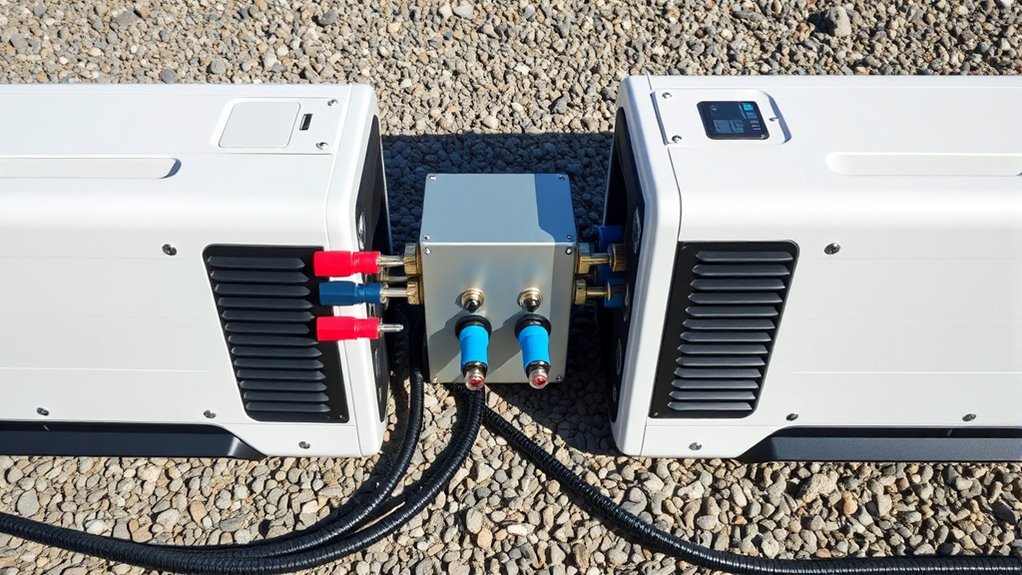To safely combine inverter generator power, you use parallel cables designed for your specific models. First, verify both generators are turned off and properly grounded. Connect them following the manufacturer’s instructions, matching connectors and securing cables tightly. Turn on the units gradually to synchronize their output. Regularly check connections during operation for looseness or damage. Proper setup maximizes power while keeping safety intact—if you want to learn more about the best practices, keep exploring the details.
Key Takeaways
- Ensure generators and cables are compatible and rated for parallel operation to prevent damage.
- Follow manufacturer instructions for connecting parallel cables securely and correctly.
- Turn off generators before connecting or disconnecting cables to maintain safety.
- Check cables and connections regularly for damage or looseness during operation.
- Proper grounding and adherence to safety precautions optimize performance and prevent electrical hazards.

If you need more power from your inverter generators, connecting them with parallel cables is an effective solution. This approach allows you to combine the output of two or more units, increasing your total power capacity without investing in a larger, more expensive generator. However, before you jump into linking your generators, it’s crucial to understand the importance of safety precautions and ensuring cable compatibility. Taking these steps helps prevent damage to your equipment and keeps you safe during operation.
First, always prioritize safety precautions when working with parallel cables and inverter generators. Make sure both generators are turned off before connecting or disconnecting cables. This prevents electrical shocks or short circuits that could damage your units or harm you. Keep the area dry and free from clutter to avoid accidental trips or falls. Additionally, confirm that your generators are on stable, level surfaces to guarantee secure connections. When handling cables, inspect them thoroughly for any cuts, frays, or exposed wires. Damaged cables should never be used, as they pose safety risks and could cause electrical faults. Properly grounding your generators is also essential; improper grounding might result in electrical shocks or equipment malfunction. Always refer to your generator’s manual for specific grounding instructions and safety tips.
Prioritize safety: turn off generators, check cables, and ensure stable, dry surfaces before connecting.
Cable compatibility is another critical factor to consider. Not all parallel cables are suitable for every inverter generator. You must verify that the cables are compatible with your specific models; using incompatible cables can lead to uneven power distribution or damage your units. Check the connectors on your generators—most modern inverter generators use a specific parallel kit with matching connectors. When selecting cables, ensure they are rated for the maximum output of your generators, typically measured in amps and watts. Using cables with insufficient capacity can cause overheating or failure during operation. It’s also advisable to use high-quality, certified cables that meet safety standards, providing reliable connections and minimizing risks.
Once you have confirmed safety precautions and cable compatibility, connecting your inverter generators via parallel cables becomes straightforward. Follow the manufacturer’s instructions carefully, aligning the connectors properly and securing them tightly. After connecting, turn on the generators and gradually synchronize their output, paying close attention to any warning indicators or abnormal noises. Regularly check the connections during operation to ensure everything remains secure and functional. Additionally, understanding the efficiency ratings of your generators can help you optimize their performance and energy savings during operation. By adhering to these safety and compatibility guidelines, you’ll maximize your inverter generator’s power output safely and efficiently, making your backup power or off-grid power setup more reliable and effective.
Frequently Asked Questions
Can I Connect Different Brands of Inverter Generators Using Parallel Cables?
You shouldn’t connect different brands of inverter generators using parallel cables. Brand compatibility is vital because different models may have varying voltage, frequency, and control systems, which can cause damage or unsafe conditions. Always check the cable specifications and manufacturer guidelines before attempting to parallel generators. Using compatible brands and matching cable specifications ensures safe, efficient operation, preventing potential electrical issues or equipment damage.
What Safety Precautions Should I Take When Paralleling Inverter Generators?
When paralleling inverter generators, you should always follow proper grounding practices to prevent electrical shock and guarantee safety. Make sure the generators are compatible and properly synchronized before connecting. Avoid overloading the system by not exceeding the combined power capacity, which can cause damage or shutdown. Regularly inspect cables for wear, and never bypass safety features. These precautions keep you safe and protect your equipment during parallel operation.
Do Parallel Cables Affect the Fuel Efficiency of Inverter Generators?
You might think parallel cables reduce fuel efficiency, but they generally don’t impact fuel consumption considerably. Combining inverter generators allows you to share the load, often improving overall efficiency. However, if the generators aren’t well-matched or if you overload them, there could be a slight efficiency impact. Overall, parallel cables mainly help increase power output without meaningfully affecting the fuel efficiency of your inverter generators.
How Do I Troubleshoot if the Combined Power Output Is Inconsistent?
If you notice power fluctuations when using parallel cables, start by checking all connections for secure contact, as connection issues often cause inconsistent output. Confirm both generators are running at similar loads and RPMs. Test each generator separately to identify if one causes the problem. Replace any damaged cables, and reset the system. Regular maintenance and proper setup help prevent power fluctuations and keep your combined output steady.
Are There Limitations on the Total Wattage When Using Parallel Cables?
You can’t surpass your inverter generator’s power capacity, even when using parallel cables. While it might seem tempting to connect multiple units for more wattage, cable compatibility and the combined power limits matter. If you push past these limits, you risk damaging your equipment or causing safety hazards. Always check your generator’s maximum wattage and ensure your cables support the total load to keep everything running smoothly.
Conclusion
By using parallel cables to combine inverter generator power, you can double your energy output efficiently. Did you know that running two inverter generators in parallel can provide up to 50% more power without needing a bigger unit? This setup not only saves money but also offers increased flexibility for your power needs. So, next time you need more juice, consider parallel connections—you’ll get the extra power you need without the hassle of upgrading.









